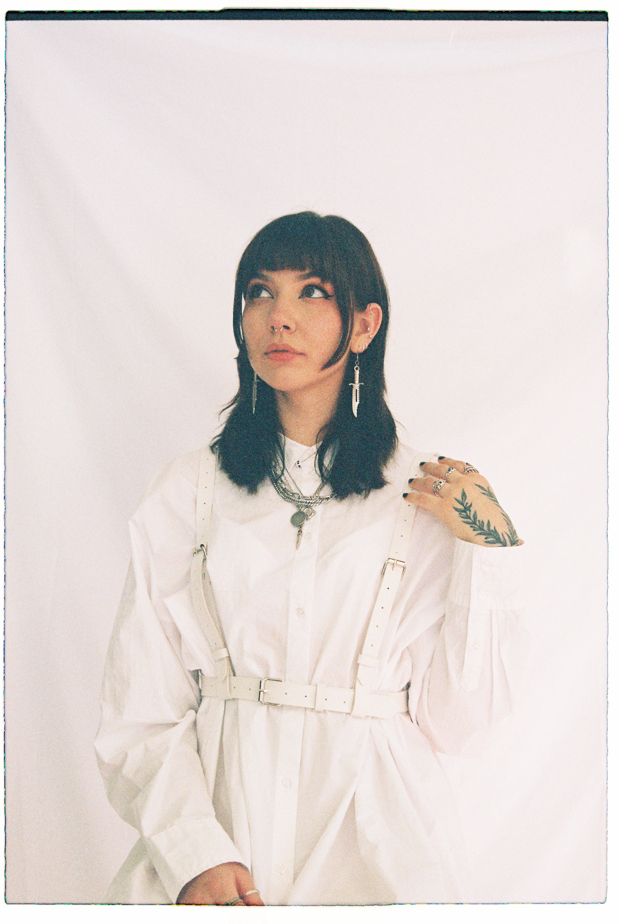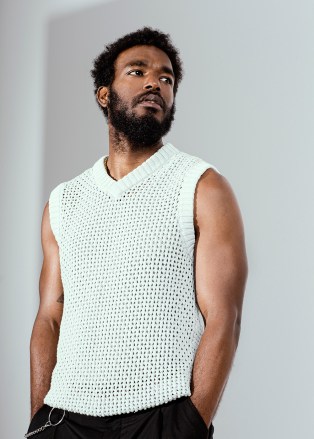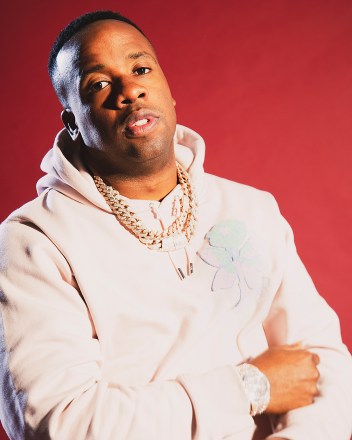If all goes according to plan, KiNG MALA will conquer the world — perhaps by the end of the year. After all, 2021 has been quite good to the LA alt-soul artist. In the springtime, the rising musical star put out the undeniably groovy, “She Calls Me Daddy,” and as summer was wrapping up, she delivered the sinisterly infectious “mercy.” In a week, on Oct. 28, she will unleash “golden retriever boy,” a song that – judging by previews – might be the thematic lovechild of her previous two songs. “It’s about f-ckboys who pretend to be golden retriever boys,” she says in a preview of the song. This hattrick will cap off a stellar 12-months for KiNG MALA, and she is more than ready for the next level. “I’ve never ever considered walking away,” she tells HollywoodLife. “For me, it’s always like, ‘If I don’t succeed now, I’ll just keep trying until it works.'”
The idea of being a successful musician was always a goal but lacked a certain “realness” – until now. “[Success] definitely feels tangible,” she says. MALA (b. Areli Castro) chatted after the release of “mercy.” That particular song has resonated with her fans, both on TikTok and on streaming services (it has amassed over 1.3 million in the first few months of its release.) When considering what has changed, MALA ponders. “People were responding well, and they liked my music, but something flipped – especially with ‘She Calls Me Daddy.’ Honestly, it was when I decided to be more vulnerable in my music, in my online personality, whatever.” Before the release of “She Calls Me Daddy,” the singer says she did some “soul searching” over what KiNG MALA’s “vibe or aesthetic was, or who I was going to try to be in this project.”

“When I kind of just decided to just be myself and just do what felt right, that’s when I feel like people started actually connecting to it,” she says. That decision extended beyond her music. “I was talking to someone the other day. And they’re like, ‘Oh, my God, like, you look like you do in that video.’ Like, I know, it’s because this is how I dress every day.” By also opening up, she was able also to resolve the differences between Areli and MALA. “The project has this kind of like, you know, like a ‘badass, no apologies’ vibe. And I was like, ‘Oh, I have to be badass and tough and mysterious.’ But I’m not. I’m super dorky. I love to talk to people. I love to overshare. Like, that’s my vibe.”
“And when I started just being myself with people, I feel like they actually started seeing who I was and what this project really means. And so yeah, I think vulnerability is key. More than anything,” she adds.
Being open and honest with her feelings was never an issue for MALA. She just didn’t know how to do it professionally. “I will tell anyone that I have no secrets. I couldn’t keep a secret, even if I wanted to, probably because I have a big mouth. But I just didn’t know how to translate that into music. And I think a big part of changing that was honestly TikTok.”
“TikTok was the first platform where I felt like I could just be myself and there was no judgment,” she says. As MALA spent more time on the app, she realized that she could just “talk and be myself, and people would connect with it.” When asked what has set TikTok apart, she said that it’s because the platform’s community has a generally healthy relationship with content that is embarrassing, goofy, or in a modern word, cringe. “I almost feel like people have just embraced the cringe on TikTok,” she says.

“Like, the Internet is cringy, and being on the internet in any way is cringy,” she adds with a smile. MALA notes that Instagram is “aesthetically based” and has developed a culture about cultivating the “visual concept of who you are,” while TikTok? “It’s just like, ‘we’re just being cringy. We’re just doing what we do.’ There’s very much energy of like, ‘don’t try too hard to be anything that you’re not because it’s obvious to people.’ Especially with my generation that grew up on the Internet, we can tell when people are trying too hard.”
“On Instagram, it’s easier to get away with that. Twitter is just a free-for-all. But I think on TikTok specifically, people have just embraced being whoever they are and doing whatever they want and not caring about aesthetic or perfect video quality or anything like that. It’s just about being vulnerable and open with the Internet.”
TikTok is also a good place to try out songs. With “mercy,” MALA had been sharing snippets for a while to see what kind of audience would react to it. “It’s a great peer review or audience test,” she says, “to see what people like or want.” So, she posted a video asking: What playlists would you put ‘Mercy’ on? The answers shocked her. “Everyone was like, ‘it’s a villain song.’ And I did not see that before. Like, I had a totally different perspective of the lyrics and what it meant and what it could mean to people. And the fact that everyone was like,’ this is like hot, villain, God complex.'”
“I went, ‘Oh my god, that’s perfect.’ When I leaned into that, it started connecting” with a broader audience, said MALA. “Once the song came out, I think people were super excited and super supportive. And I was excited about the video. And I feel like it went over – even better than I expected.” Though, MALA did stress that she doesn’t test screen everything. She previewed the “mercy” video but kept most of it under wraps until its release date. “I think it’s a there’s an important balance between sharing stuff before it’s out,” she says, “But also [having] stuff to give once the song is out. The video was the part I saved it. But the song itself, it was kind of like audience test.”
With this audience input, “mercy” transformed from a song about being introspective on traits that are dubbed “negative” — I’ve been getting so tired / Starting so many fires / I always find a way to burn / Now I’m begging for mercy / From everyone that I’ve wronged,” she sings at the start – to a villain’s anthem. Originally written as a piano ballad, “mercy” was MALA “coming to terms with the negative parts of myself, especially since I’m a person who has dealt with mental illness,” she says. “I’m bipolar, so there’s a lot of ‘what’s me and what’s not me – who is the real me?’ That song was delving into that aspect of myself. ”
“And then, even with the video, and with everyone connecting with it the way that they did, it felt like I too, came to the realization that accepting and empowering all the parts of us are so important,” she says. Even watching the video – where her “evil” side torments her “good side” – she finds that “the bad version of me looks more like me than the good.”
“Everything about you makes you who you are,” she says when touching on the core message of “mercy,” “and reveling in the things that like people would consider bad or like allowing your arc to be what it is, even if it is a villain arc. Just letting yourself be who you are and accepting all the parts of yourself. Even if I’m not what society says is good or fair or whatever, I’m still powerful, and I still deserve to be the main character. I still deserve to be who I am.”
Does MALA see herself as a villain? In a sense, she says. “I never want to make anyone feel bad or be mean to people,” she stresses. “I’m very loving, and I think I’m nice to people. But, we do have these parts of ourselves. We can be selfish, and we can be narcissistic. That feels more realistic to the actual human experience. Being the hero and being the good one? That is harder to achieve than just accepting yourself for your flaws and trying to do better anyway. So I think, in a way, I’m a villain.”
“KiNG MALA is also the villain against the cis-hetero patriarchy, as seen in her queer-positive works like “She Calls Me Daddy.” She says that there are “so many things about myself that I would consider anti-norm,” before listing the traits: “I’m queer, I’m super tall, I’m bipolar. I’m like, all these things that are considered villainous kind of traits. And so, I learned a long time ago that I didn’t want to be like anyone else. And I didn’t want to lean into what felt ‘normal’ and what felt, you know, accepted, because I couldn’t do it even if I wanted to and because the only way to survive is just to accept yourself and love yourself for who you are.”

The discussion of queerness at the villain came in the wake of Lil Nas X’s “Montero” video and the controversy of a gay man accepting his damnation to hell where he could be openly himself (and kill the devil after giving Satan a lap dance.) Mala praised Lil Nas X for taking the role that he and other queer people were given by society and “empowering yourself in the role. “It is absolutely just genius.”
Leaning into the villain role was something MALA learned as a teenager. It was, as she put it, “a survival tactic when I felt totally like an outcast from every group and thing I walked into. ‘Well, if I’m going to be the outcast, I’m going to be the most badass outcast there is.’ I’m going to lean in and be my main character in this story, even if I’m the villain. So, I think part of [“mercy”] is empowering. It’s how we’ve always survived. It’s leaning into our otherness.”
With the promise of new music – “I am working on an album,” she shares – there are plenty more chapters left to write in the KiNG MALA story, and many eager readers are ready to see how this story unfolds.


